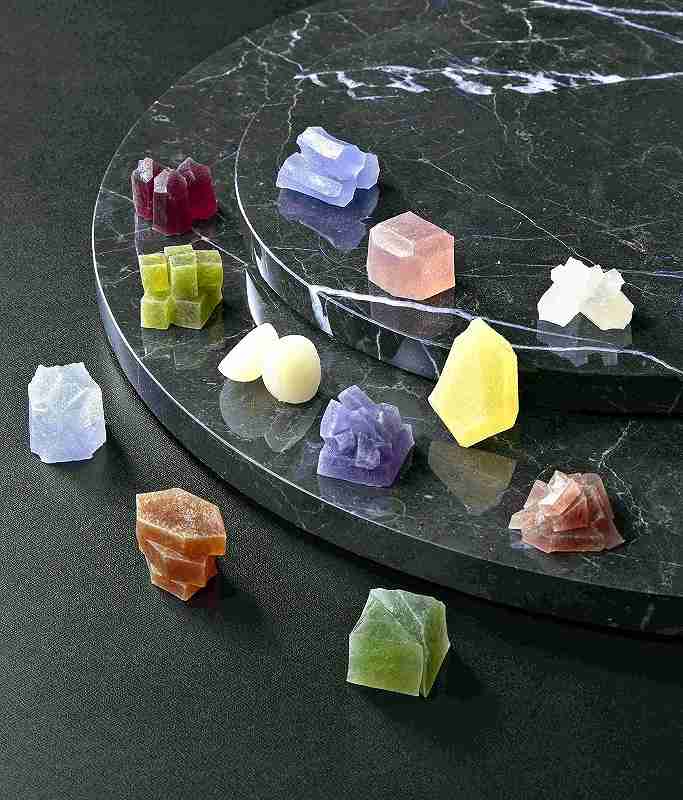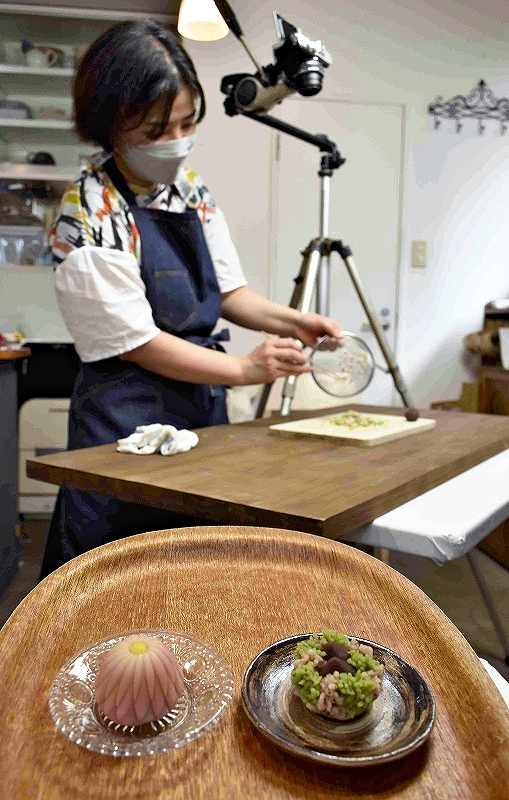
Kohakuto Okada’s birthstone-themed kohakuto sweets
13:18 JST, November 1, 2022
Wagashi are traditional Japanese sweets that have long been a part of the everyday life of the Japanese through various occasions such as seasonal festivals and celebrations. Because of their long history and tradition, the sweets often have a prestigious image. But they actually match the trend of the Reiwa era in many ways.

Keiko Omori takes pictures of wagashi-making in Tokyo. In the foreground are delicate wagashi sweets.
Keiko Omori, 40, who runs confectionery-making class Yuimiko in Tokyo, demonstrates how to make a wagashi resembling a chestnut in a video. She pushes green and light-brown red bean paste through a strainer to make them into a fine crumble, or soboro. When shaped into a ball with chopsticks, the soboro soon turns into the shape of a chestnut.
Wagashi portray the seasons with their delicate colors and shapes, and it is these characteristics that are getting attention as they fit the trend of taking attractive photos to share online.
Omori, who has published wagashi recipe books, teaches many students in the offline and online classes she started during the COVID-19 pandemic. “Recently, more people want to learn how to make nerikiri sweets,” she said. Nerikiri is made by combining and shaping soft mochi called gyuhi and white bean paste called shiroan, using tools and hands.
Omori said some people became interested in nerikiri-making after seeing the sweets on social media, even though they had never eaten them before.
The shapes and colors of wagashi have meaning. A sense of the season is especially valued. The chestnut wagashi, for example, indicates through the mixture of light brown and green “burrs” how chestnuts change their color as autumn deepens.
“When I make a new wagashi design, I sometimes look up kigo [words or phrases associated with a particular season used in haiku poems] to call up an image,” Omori said. “I want people to become interested in wagashi from their appearance and then find out how tasty they are.”
Gems and characters
There are also new types of wagashi that take advantage of their free-form properties and photogenic appearance.
Bandai Co.’s Tabemasu, or Taberareru Mascot, are nerikiri sweets featuring popular characters from manga and other sources. They have been sold at convenience stores and supermarkets since 2015.
Bandai said the combination of popular characters and wagashi, two cultural features distinctive to Japan, will create appealing products.
Bandai has made Tabemasu sweets for about 60 characters, including those from popular anime “Yokai Watch” and Sanrio Co., attracting the younger generations in particular. Their fans are said to often post photos of the wagashi on social media.
Instagrammable wagashi are not only those made with bean paste. Kohakuto, a jelly candy with a translucent appearance, is also attracting attention.
Kohakuto, which literally translates to “amber sugar,” is made by adding sugar to kanten agar dissolved in water.
Since last year, Minamoto Kitchoan Co. has been offering 12 kinds of kohakuto themed on birthstones in different colors and shapes under the brand name of Kohakuto Okada. Blueberry-flavored kohakuto for February looks like a piece of amethyst, and matcha-flavored kohakuto for August looks like a real peridot stone.
“It’s natural for today’s confectionery to taste good. They need to have added value such as a beautiful appearance,” a company spokesperson said.
Tea ceremony culture
The distinctive appearance of wagashi is associated with its history. Kazuma Tawara, a curator at the Osaka Museum of History in Osaka City, said wagashi have always been an integral aspect of the tea ceremony, which values a sense of the season. “Unlike simple and plain foods eaten by the common people, wagashi eaten in the tea ceremony needed to have a visual appeal that matched the occasion.”
An exhibition Tawara curated for the museum earlier this year included a collection of picture books of confectionery from the Edo period (1603-1867). A variety of colorful designs thought to have been created by confectioners at the time are introduced in the books, revealing that the Japanese were working on the appearance of wagashi more than 300 years ago.
"Features" POPULAR ARTICLE
-

Sanrio to Open Museum in Yamanashi Pref. Dedicated to Founder, Exhibits Include Hello Kitty, Other Characters
-

Autumn Foliage Surrounds Visitors to Tokyo’s Showa Kinen Park
-

My Daughter No Longer Speaks to Me, But I Want to See Her and My Grandchild
-

Kumamoto: Public Bath Refurbished as Library Where You Can Chat, Take Photos
-

Frozen Vegetables: Demand Rises for Convenient, Tasty Domestic Produce
JN ACCESS RANKING
-

Tokyo Economic Security Forum to Hold Inaugural Meeting Amid Tense Global Environment
-

Keidanren Chairman Yoshinobu Tsutsui Visits Kashiwazaki-Kariwa Nuclear Power Plant; Inspects New Emergency Safety System
-

Imports of Rare Earths from China Facing Delays, May Be Caused by Deterioration of Japan-China Relations
-

University of Tokyo Professor Discusses Japanese Economic Security in Interview Ahead of Forum
-

Japan Pulls out of Vietnam Nuclear Project, Complicating Hanoi’s Power Plans
























